More on Reality and THEE Domains
Conjectured Divisions
There are 7 Primary Domains in THEE corresponding to the Root Levels. Previous research indicated that to each had their own distinctive reality form and truth quality. and served these lower Domains and did not generate forms of reality of their own.

The 5 lower Domains can be divided and categorized in three ways:
Principal Division of the 5 Lower Domains
- Domains where reality form arises spontaneously: .
-
The where reality is specifically "constructed" for different purposes, and where that purpose will determine the reality form in play—regardless of the reality form that we might prefer to use to produce what we might imagine are better results.
This was a disturbing finding. See TET at right:
Categorization of the Spontaneous Forms
- and both deal with down-to-earth empirical reality.
- and generate psychosocial reality, whose existence conventional science refuses to acknowledge.
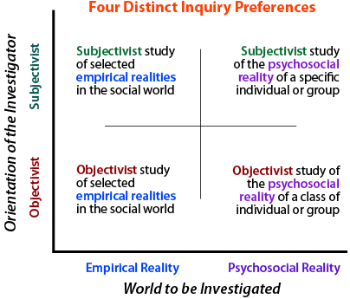
These divisions were the basis for the X-axis of an analysis performed very early on in this taxonomic inquiry, and long before domains or reality forms were formally conceptualized. See diagram at right and further details in the Hub. Note that THEE research is located in the lower right quadrant.
The Y-Axis in the diagram used another division that now deserves notice:
- The -generated reality is taken for granted as objective reality, and the investigator based here has an objectivist orientation.
- The -generated reality is taken for granted as subjective reality, and the investigator based here has a subjectivist orientation.
- But that leaves open a big question: what about reality in the other 3 Domains: ?
Investigations undertaken more recently have clarified that appear to be involved in creating, discovering or determining what reality is i.e. they provide the substrate, the objects, for objective or subjective study of either or psychosocial reality.
Discovering Reality
When it comes to discovering reality, two orthogonal dimensions have emerged as critical:
►
►
| In , these dimensions formed the Executing Duality: |
In , these dimensions formed the Approach Duality: |
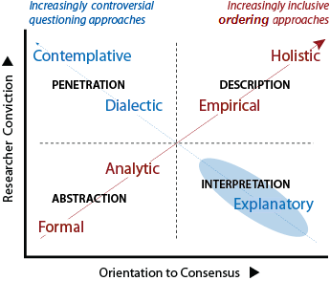
|

|
What this means is that consensus and conviction define the psychosocial field within which into reality occurs. Whereas consensus and conviction distinguish the seven used to create reality.
Comparing RL2-Inquiry & RL5-Communication
Investigation of the , revealed it was about and to get —all under a pressure of certainty. The also provided frameworks for reaching conclusions in a variety of dynamic situations where conventional research is inappropriate or inapplicable.
takes the position that reality is unknowable. But that appears to be self-deception, because the conjecturing depends on which is knowable practical reality. can also be based on RL4-subjective reality as noted above (see examples here).
Question: where did that RL1-practical reality or that RL4-subjective reality come from?
Answer: it appears to come from which is probably why issues of conviction and consensus also appear there.
Investigation of the different via the TET revealed that reality is discovered under social auspices, but it is constructed under personal auspices. Entities may be depicted under either personal or social auspices.
| RL2-INQUIRY DOMAIN: RESEARCH
|
RL5-COMMUNICATION DOMAIN: LANGUAGE |
RL3-CHANGE DOMAIN: DEPICTION |

|
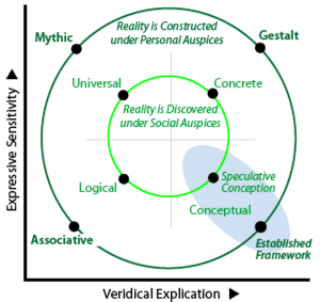
|
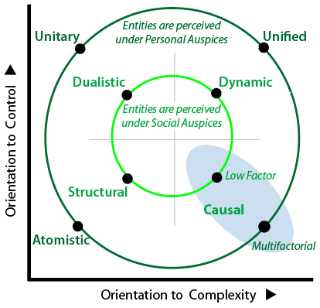
|
The different quadrants containing the each take a distinctive approach to reality (see below on left); and there appears to be a cycling around the quadrants (see below on right). What that investigation suggests is that reality is conceived and incorporated using the —which turns out to be the .
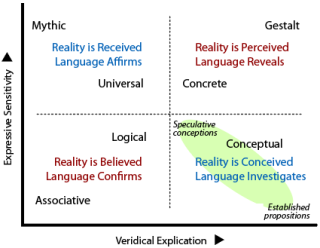
|
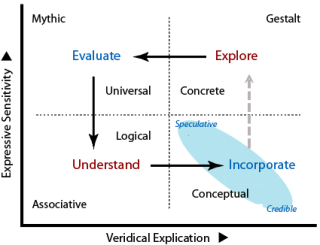
|
|
See a full explanation here. |
The nature of the findings during are variably handled as shown. Note the different communication styles linked to conviction, and the quality of findings linked to consensus.
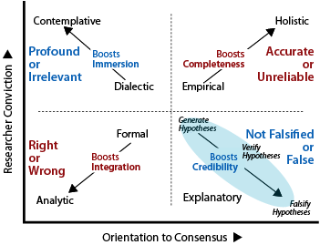
|
Click to popup full-size image.
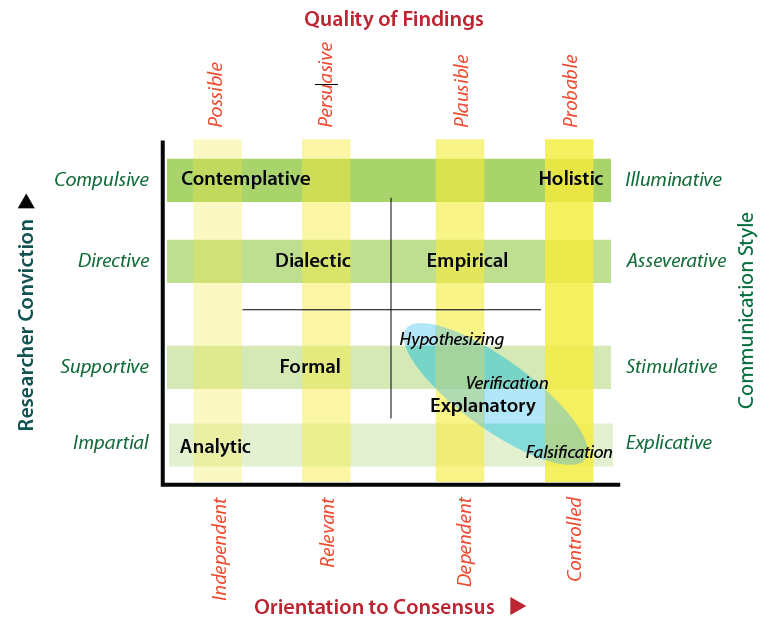
|
What is noticeable is that objectivity and subjectivity are handled very differently by the various .
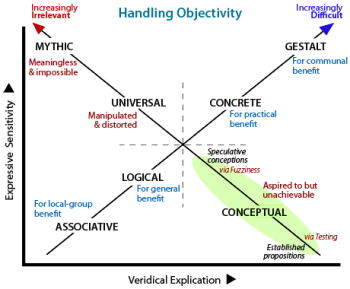
|
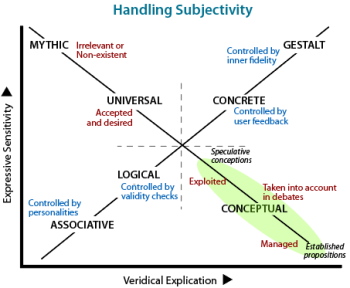
|
"Construction" of Reality via RL3-Change
is where the rubber hits the road. More than anything else, we want things to change for the better, or to stay the same if we like things as they are. All endeavour can be seen in these terms. Both and serve these ends of preservation and improvement.
While the notion of constructing reality was used in explaining how underpins psychosocial functioning, this is not the self-conscious constructed reality form, self-interested and perspectivist, that characterizes the .
Unlike the arcane and highly focused nature of or the implicit, near invisible nature of , the contains the that shape the perception and clarification of any situation, and that are deliberately (if mostly unconsciously) used to achieve desired ends.
confronts the potential of real-world complexity and the human desire for control. If ignoring complexity increases control, then that may be judged a worthwhile trade-off with veridicality deemed irrelevant.
In any case, is pressured by acceptability and meets the need to fit in. All that is required for this is plausibility. These factors have a major impact on any attempt to determine reality. For example, despite the high status of academic science, investigation revealed what those involved know only too well: are primarily driven by acceptability, even if individual researchers can choose to fight a faulty consensus.
In the next sections, we will develop frameworks that reveal:
-
how the best of all depiction paradigms can be extracted and cumulated so that situations can be clarified as well as possible
-
how the pressure for acceptability provides determinants for fitting in to the group and for criticism of any clarification.
-
Continue to how situations get progressively clarified.
-
Return to the review.
Originally posted: 10-May-2025.